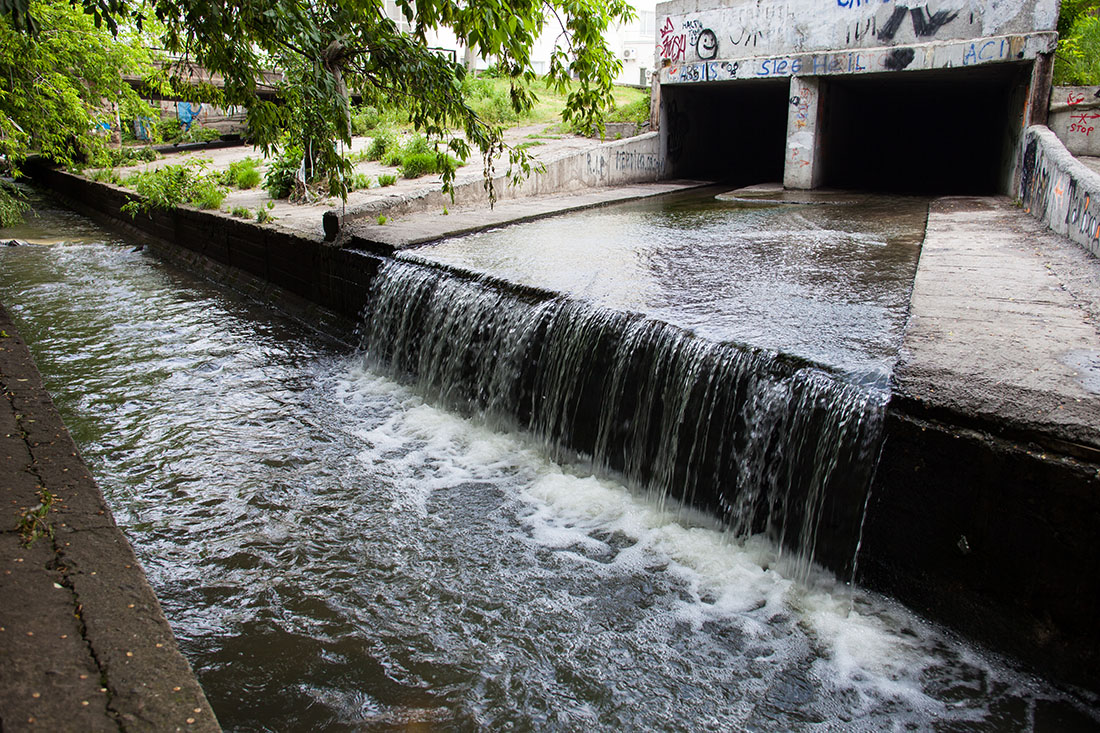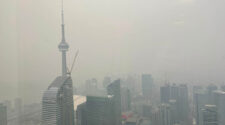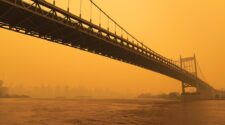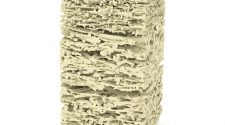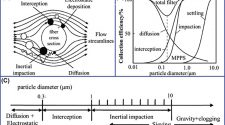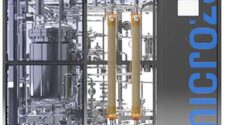Why should we care about stormwater? Have you ever wondered what a mass extinction event might look like? Certainly, such events are well documented in the geologic record, involving gamma ray bursts, asteroids and comets, and perhaps the biggest killer so far, volcanism.
Volcanism is commonly accepted as the cause of the Permian-Triassic extinction, also known as the “Great Dying.” During this period, 96 percent of all marine species died off, and there was an equally devastating effect on terrestrial species, essentially killing off the amphibian and reptilian megafauna in addition to many plant species. Giant fissures known as the Siberian Traps opened for thousands of years, altering atmospheric and marine chemistry.
All of these causes of extinction events had a devastating effect, but we have no geologic record of the most pernicious and quite possibly most devastating cause yet, us.
Just look around … By many published measures, the current extinction rate in species lost per year exceeds the Great Dying (1). According to the United Nations Environment Programme, the Earth is losing an estimated 150-200 species per day, which equates to 1000 times the “natural” rate and likely greater than the dinosaur vanishing (2). One of the greatest current causes is loss of habitat and a polluted ecosystem. Preservation of habitat is vital, as ecosystems are unable to regenerate below a critical size and connectivity.
Polluted stormwater runoff is a reckless form of habitat destruction. It is a guiltless form of remote littering, as most people will never encounter the creatures and ecosystems being needlessly damaged. At the same time, overpopulation and a rise in consumerism in the present age makes the issue of pollutants in stormwater a more pressing concern than it has been in the past, as resources like clean water become more finite.
How stormwater is handled
To fully understand why stormwater is such a threat to life on this planet, you have to understand why it is such a challenging riddle in the first place. The approach to handling stormwater in the United States is the same approach the Romans used. Stormwater is channeled into permanent drains, which flow into the nearest body of water untreated and unfiltered. With the exception of cities with combined sewer systems (mainly on the U.S. East Coast), this is the same approach that is used today ̶ stormwater flows directly into a nearby body of water through a separate sewer system (MS4 – Municipal Separate Storm Sewer System).
Municipalities with combined sewer systems are slightly different than an MS4 because most of the stormwater and sewage flows through the municipality’s water treatment facility prior to discharge. However, in times of high flows (e.g., large storm events), the stormwater and sewage overflows diversion mechanisms and is diverted directly into the watershed and bypasses water treatment facilities.
Why aren’t all cities using combined sewer systems? Because it is very expensive to overhaul a city’s sewer system to separate the stormwater from the sewage lines. Basically, the combined sewer system is old technology that dates back to the America’s colonization of the East Coast when the river was an acceptable place to discharge raw sewage and stormwater pollution. That’s why they are seen mainly on the East Coast. Combined sewers made sense in the 1800s because:
- Cities were smaller and less populated;
- The level of water treatment being done at the end of the pipe was minimal;
- There were no regulations regarding the effluent; and
- Water pollution was not a main concern at the time.
Generally, combined sewer systems are not a model to mimic in the future. The modern and scalable approach is to treat stormwater as different from sanitary wastewater.
Sampling of sewer type by city
MS4
- Los Angeles
- Denver
- Mainly west of the Mississippi River
Combined
- New York City
- Philadelphia
- Mainly cities in the Northeast
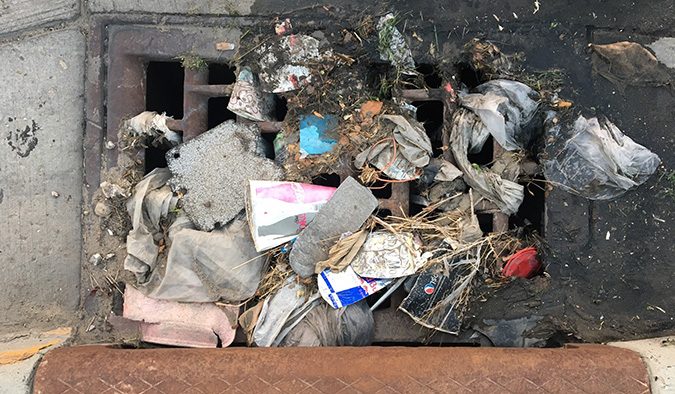
The human factor
All stormwater starts off clean as it falls from the sky, but as it comes in contact with human activity, it usually becomes polluted. Common pollutants are:
- Trash: Cigarette butts, plastic, paper, aluminum
- Organic waste: Feces, urine, food waste
- Sediment: Asphalt, paint chips, tire treads
- Hydrocarbons: Oil, rubber, petroleum products
- Heavy metals: Lead, zinc, copper, aluminum, iron
- Vegetation: Leaves, grass clippings, and associated agricultural waste like fertilizers & pesticides
Stormwater mixes with these pollutants and becomes polluted. It is then channeled into a storm sewer network and eventually discharged into a nearby body of water.
While the Clean Water Act of 1972 and subsequent regulations at the local, state and federal level have dramatically improved water quality by regulating point source polluters such as industrial and agricultural entities. Regulating point source pollutants is an easier challenge to solve because of its focused discharge point from a known industrial source. Municipal stormwater is a much more difficult challenge. Stormwater is mainly a nonpoint source of pollution, meaning its inputs are diffuse and may come from tens of thousands of storm drains interspersed throughout a city.
A city such as Denver has 22,000 storm drains; not including the multiple suburbs. Each drain is an opportunity for pollution to enter unabated into the network and flow to the South Platte River. Unlike industrial polluters, monitoring individual or clusters of storm drains for pollution load is nearly an impossible task.
Just look around … By many published measures, the current extinction rate in species lost per year exceeds the Great Dying.1 According to the United Nations Environment Programme, the Earth is losing an estimated 150-200 species per day, which equates to 1000 times the “natural” rate and likely greater than the dinosaur vanishing.2
There is a compounding effect at play. Relatively low pollutant loads spread out across thousands of storm drains result in an unacceptable pollutant discharge into the watershed.
Of all this trash and pollution being washed to Earth’s watersheds each year, is there a pollutant that stands out from all the rest? Many believe that cigarette butts are one of the worst pollutants because of the 12,000+ microplastic cellulose acetate fibers found in each butt plus the 3000+ toxic chemicals found in each filter. Researchers have determined that one smoked cigarette butt placed in a liter of water will kill five out of 10 fish in a 48-hour period (3). To bring this example into focus, suppose each Denver storm drain collects and discharges just five cigarette butts per month into the South Platte River. If this were a factory, such a pollution contribution wouldn’t even raise the eyebrow of the most ardent inspector. However, if you multiply that out across the 22,000 Denver storm drains throughout an entire year, the result is that over 1.3 million cigarette butts find their way into the South Platte River with enough potency to kill 6.6 million fish. If this were a point source polluter, local, state and federal regulators would have shut down the operation for posing such a dire threat to the watershed. And the problem is probably far far worse. Based on Colorado cigarette sales records and global littering rates, an estimated 309 million cigarette butts were littered in Denver last year alone, with a significant percentage finding their way into the local watershed.
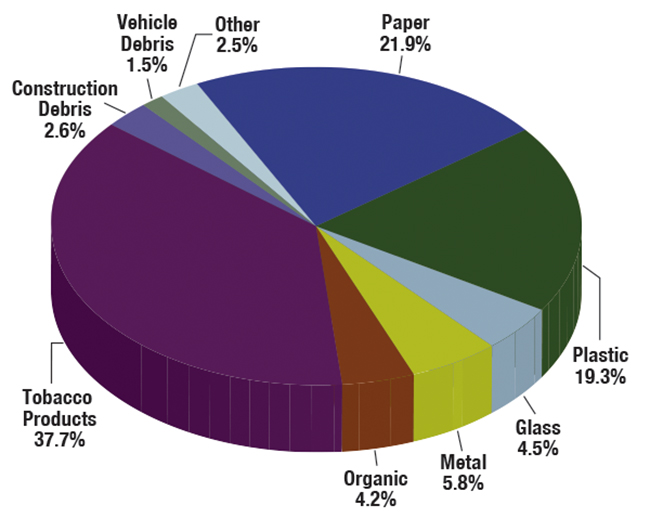
The best analogy to understand the threat of nonpoint source pollution is to think of the local watershed as a patient in an emergency room. If our hypothetical patient were to walk into the waiting area in with a half inch cut on his leg, he would be sent home with a Band-Aid and a stern lecture. But if our patient were to appear in the ER waiting room with 1.3 million half inch lacerations on his body, it would be a code red emergency. This is the practical reality of stormwater pollution today.
The challenge of infrastructure & scalability
Unlike sanitary sewers, which have a relatively predictable level of flow, stormwater sewers are a story of extreme peaks and valleys.
During high moisture events, the demands on the storm sewer network are great. The primary job of a storm sewer is to get water off of the streets and other areas of habitation. It cannot fail or the results can be catastrophic and deadly.
Stormwater treatment solutions must be able to not only function adequately at peak levels; they must also have incredibly robust failover to prevent catastrophic large-scale flooding in the event of a clog. The level of treatment increases the likelihood of capacity failure – the more treatment, the more likely it is to fail under a heavy storm load.
Perhaps the most concrete example of this is the old combined sewer system with the water treatment plant being the ultimate end-of-pipe solution. But, to protect against the dangers of flooding, the system bypasses the water treatment plant and spews the untreated stormwater right into the river during storms (aka “urban slobber”), thus defeating the purpose of treating stormwater before it reaches the waterway.
The question remains … How is it possible to construct end- or mid-pipe infrastructure to deal with stormwater in a safe, economically viable, and effective manner? The conclusion to date has been that end- or mid-pipe solutions are costly and complex, while also introducing a dangerous choke point or single point of failure. Most end or mid-pipe solutions simply bypass during large storm events – when their service is needed most – sending millions of gallons of untreated stormwater pollution directly into the watershed.
A problem that won’t go away
Unlike industrial wastewater pollution, which is tied to economic activity and private pollution capture infrastructure, stormwater pollution is directly related to the number of people in a municipality. As cities grow, so does the stormwater pollution problem because many stormwater networks were not sized adequately to accommodate future growth. The stormwater infrastructure that is currently in the ground for most municipalities is aging, overtaxed and underbuilt with an approach that completely ignores any concept of treatment. Yet the population keeps growing – putting more and more demands on the system.
With the passage of the 1972 Clean Water Act, (and the formation of the Environmental Protection Agency in the 1970s), municipalities in the U.S. had to start worrying about meeting regulatory requirements. Over the years, layer after layer of regulatory requirements have been enacted, increasing the requirement that municipalities must meet.
While stormwater was of marginal concern just a decade ago, stormwater districts are now focused on meeting MS4 permit requirements, and the penalties for being out of compliance are massive. For example, Colorado Springs, Colorado, recently spent well in excess of $3 million on a lawsuit over stormwater permit violations. Ultimately, the city decided to end its legal battle over the matter and is working toward a settlement and measures to ensure compliance going forward (4).
States have also enacted their own level of requirements. For example, California’s Stormwater Trash Implementation Program has mandated that by 2030 it will be a violation of MS4 permitting requirements if any trash 5mm or larger enters a stormwater network and is discharged into a body of water.
With an estimated four million storm drains in California alone, and the challenges posed by mid- and end-of-pipe solutions, it is clear that the focus must turn to protecting each individual inlet.
Did you know?
Industrial vs. municipal stormwater
Industrial stormwater is mainly regulated at its source, as companies are required to meet specific regulatory standards for effluent under the industrial general permit (IGP) system. This is because the toxicity of industrial stormwater is often much higher than what is found in municipal systems. For example, the Port of Long Beach Shipping Terminal (Long Beach, California) must deal with hydrocarbon and heavy metal accumulation on site, which requires periodic cleaning and filtration of the resulting water. One water sample taken at the Port of Long Beach found total suspended solid levels at 33,200 ppm, iron at 1,380 ppm, and hydrocarbons at 110 ppm. Given the potential for such high levels of contamination, industrial systems often require costly enhanced treatment solutions to maintain compliance.
By contrast, municipal stormwater is typically handled with very little – if any – treatment. The most common form of treatment in municipal systems is retention ponds for sediment collection, and most MS4 stormwater is discharged directly into the watershed.
From an enforcement perspective, monetary fines for violations are levied at both the industrial and municipal level. The major difference between industrial and municipal systems is in the ability for the infringing entity to take action to remediate current violations and prevent new ones. In industrial scenarios, it is much easier to overhaul infrastructure and business practices, while municipal systems are extremely challenging to overhaul, as the infrastructure is buried and treatment practices are antiquated.
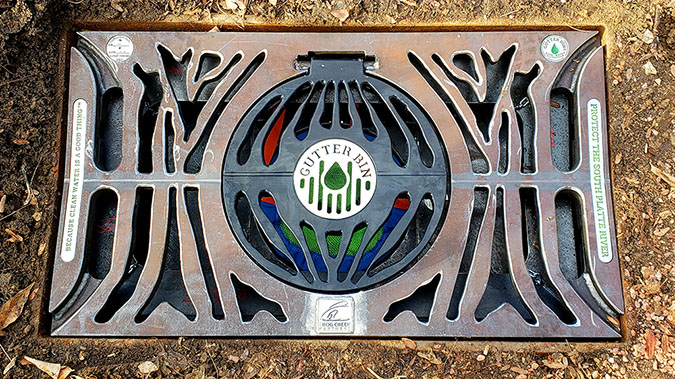
Stormwater solutions
Current options for municipal stormwater systems include end-of-pipe solutions, including trash nets, retention/detention ponds, etc. However, these solutions take up a lot of room, and many cities don’t have the real estate to employ large retention/detention ponds. Meanwhile, mid-pipe solutions, such as centrifugal separation units, are expensive to install and maintain. As such, inlet protection and filtration systems are emerging as one of the most effective, affordable and scalable options for meeting ever-increasing local, state and federal standards.
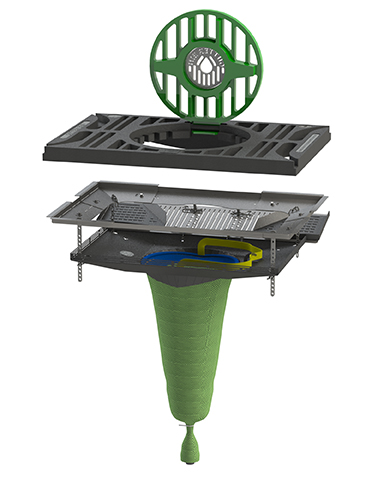
Inlet stormwater filtration systems are designed to retrofit existing drop or combo inlets, as well as trench drains. Inlet systems are capable of handling trash, vegetative waste, sediment, hydrocarbons and heavy metals. In fact, a recent pilot project for the City of Denver utilizing inlet stormwater filtration produced an average capture rate of 205 pounds of pollution per year per catch basin.
Keeping cigarette butts, water bottles, plastic straws and sediment out of the watersheds is one thing. The compounding effect of nonpoint source pollution created by inlets draining hydrocarbon-tainted stormwater from city streets is another level of toxic pollution entering the watersheds and eventually being transported to the ocean. According to the USEPA, the stormwater discharge from one square mile of roads and parking lots can yield approximately 20,000 gallons of residual oil per year.
Emerging trends
PFOA/PFOS, polyfluorinated octanoic acid compounds, are used as film forming agents in firefighting foams (AFFF-aqueous fluorinated firefighting foam), in scotch tape, polymer manufacturing, and other uses where its surfactant properties are desired. Polymerizing PFOA/PFOS would produce Teflon; just as polymerizing CFC (chlorofluorocarbon) refrigerants would, more or less.
PFOA/PFOS are very inert compounds of low toxicity and low chemical reactivity, meaning they hang around a long time. In the case of CFCs, they hung around until they got to the stratosphere and the ultraviolet (UV) radiation disengaged the chlorine, causing Ci free radical destruction of ozone (100K ozone per Cl free radical). You can think of refrigerant CFCs as gaseous Teflon.
Similarly, the AFFF and their kin can be viewed as liquid Teflon. These have been used for a few decades at all airports, military bases, and in many manufacturing facilities. When it rains, they partition quickly to the aquifer. As a consequence, they are present almost everywhere we look, agriculture feedwater aquifers, the highest peaks in the Andes, etc.
Just as we did not know what CFCs would do initially; it was bad. Now there is similar concern with PFOA, et al, in relation to autistic kids, insects and amphibian extinctions, etc. This issue has finally been getting a bit of press, and it is perhaps the most important emerging stormwater issue.
Case studies in stormwater success
City of Denver cleans up its stormwater act
Frog Creek Partners, a manufacturer and designer of inlet stormwater filtration system, installed 12 of its Gutter Bin® stormwater filtration systems in Denver, Colorado, in April 2018, immediately before the 420 Festival near the Capitol Building and in other high-polluting areas. Because Denver has minimal-to-no stormwater filtration measures in its downtown area, Frog Creek worked closely with The Greenway Foundation (TGF) in a public-private partnership where TGF donated three custom-branded Gutter Bins to the project.
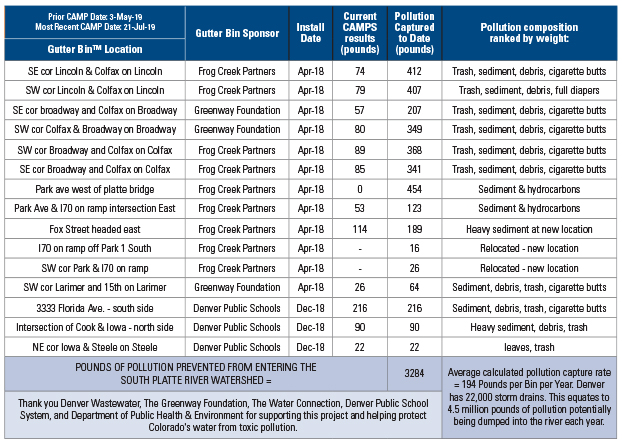
Denver’s Civic Service Park is known for having a large transient population, and it is a hub for local festivities. City officials were interested to see how Frog Creek’s patent pending Gutter Bin stormwater filtration system and Mundus Bag® water filter performed in high-traffic areas. After the install, the Mundus Bag water filters were checked periodically to ascertain pollutant load and effectiveness. It was found that the bags needed to be replaced or emptied every four to six weeks during the summer months and about every eight weeks in the winter months. During the course of a year, no flooding was experienced at the pilot location, and the 12 Gutter Bins captured 2,473 pounds of plastic, cigarette butts, hydrocarbons, debris, hypodermic needles, ammunition, microplastics, and sediment with little-to-no trash bypass. Denver has 22,000 storm drains in the downtown area alone and this pollution rate equates to over four million pounds of pollution being flushed to the South Platte River each year — not including the suburbs of Denver.
Gutter Bin technology saves Denver Zoo $40,000 per year
The Denver Zoo employed the use of Frog Creek’s Gutter Bin technology to address chronic lion moat and parking lot flooding. Frog Creek was able to replace low-tech storm drain grates at the zoo with their pollution catching, clog-free solution to save the Denver Zoo approximately $40,000 per year in vacuum truck clean-up costs while increasing up-time for patrons wanting the full Denver Zoo experience.
The zoo faced a yearly problem where trash and debris from its parking lot clogged the stormwater network that fed to the lion’s moat. The only way to solve this problem was to hydrojet and vacuum the trash out at great yearly expense. The solution was simple enough for the Denver Zoo staff to clean out the Mundus Bag.
“What started as a clogged storm drain turned into a wonderful relationship right in line with our commitment to sustainability,” said Jennifer Hale, senior director of campus management and sustainability for the Denver Zoo. “The plastic litter and debris in our parking lot has a history of clogging the storm sewer system that eventually leads to the lion enclosure, which is a huge problem for us. With Frog Creek Partners’ solution, we’re able to avoid substantial clean-up costs and we have a permanent way to keep our stormwater free of pollution, far more benefit than we initially bargained for.”
Port of Long Beach Shipping Terminal addresses hydrocarbon pollution
Frog Creek also partnered with MYCELX, a provider of oil-free water solutions to the oil & gas industry, to develop an inlet filtration system that has proven successful in removing hydrocarbons from stormwater. Utilizing a polymer-based solution that facilitates molecular cohesion to remove oil from water, the technology helped the Port of Long Beach Shipping Terminal reduce hydrocarbon levels and other pollutants (i.e., TSS, organics, and heavy metals) to ensure compliance with California IGP requirements. The MYCELX technology with inlet filtration systems offered the ability to tailor filtration to each inlet at the port, thus significantly reducing the overall hydrocarbon discharge from the port’s stormwater network and resulting in a healthier and cleaner marine environment.
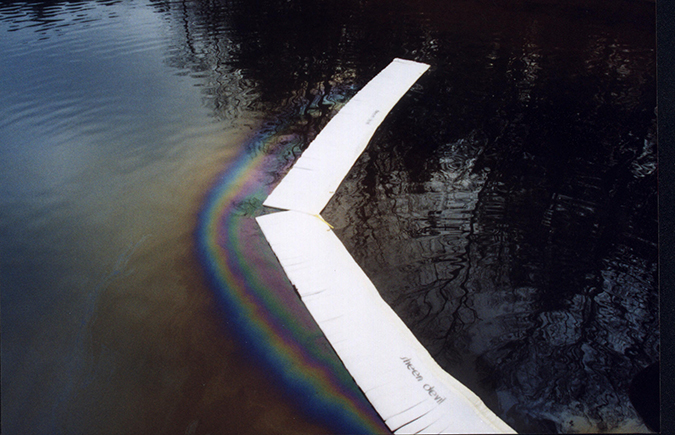
Parting shots
From a municipal perspective, the current method of stormwater handling is an archaic solution focused solely on removing stormwater from areas of human activity. However, current methods of stormwater handling are completely inadequate when it comes to pollution control.
Changing the approach will require regulatory and public pressure. Municipalities won’t move without pressure, and while regulations are increasing, enforcement is lacking. This is changing though, and many cities are starting to feel the impacts of regulatory requirements on stormwater. Public pressure is also ramping up, as pollution on a variety of fronts is a source of growing public outrage, resulting in outcomes such as plastic straw bans, plastic bag bans, single-use plastic restrictions, and Styrofoam bans.
On the industrial side, the move by governments to enact extended producer responsibility (EPR) requirements mean producers of commonly littered items will have to take responsibility for the products they manufacture throughout their lifecycle. The European Union is already moving in this direction and U.S. states like California and Maine are considering EPR legislation. EPR laws are already commonplace for such items as used tires, batteries, paint, and electronics.
That said, all isn’t doom and gloom. You can catch fish in the Cuyahoga river today; 50 years ago it was on fire. This is because of laws like The Clean Water Act and The Clean Air Act – two of the most successful pieces of federal legislation in the history of the United States.
Smart regulation works; without it, we’d be far worse off as a nation and as a planet. Smart regulations facilitate innovation and public/private partnerships to make it easy to “do the right thing.”
Stormwater pollution is a massive problem that must be solved. There is no one-size-fits-all solution, but we must take immediate steps to stem the flow of pollution to our rivers and oceans by any means necessary. Otherwise, it is conceivable that our descendants will only know what a whale, dolphin or coral looks like by searching for old pictures on the internet.
References
- Barnosky et al, 3 March 2011, Volume 471, Nature.
- “UN Environment Programme: 200 Species Extinct Every Day,” Huffington Post, May 2011.
- Slaughter et al, “Toxicity of cigarette butts, and their chemical components, to marine and freshwater fish,” Tobacco Control, May 2011.
- “Federal stormwater lawsuit has cost Colorado Springs more than $3M and counting,” Colorado Springs Gazette, Nov. 2018.


